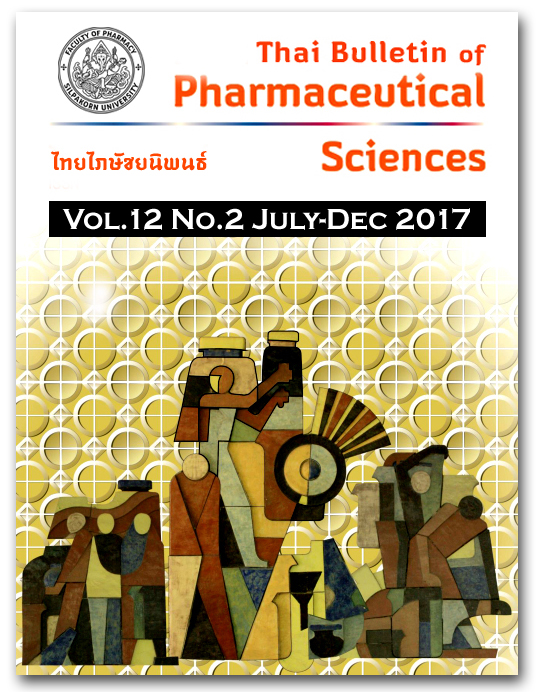CORRELATION BETWEEN THE ANTIMICROBIALS UTILIZATION AND ANTIMICROBIAL- RESISTANCE IN PRASAT NEUROLOGICAL INSTITUTE
DOI:
https://doi.org/10.69598/tbps.12.2.21-29Keywords:
ปริมาณการใช้ยา, การดื้อยาต้านจุลชีพ, utilization, antimicrobial-resistance, Defined Daily Dose (DDD)Abstract
สถาบันประสาทวิทยาเป็นสถานพยาบาลระดับตติยภูมิ มีปริมาณการใช้ยาต้านจุลชีพในกลุ่ม carbapenems (CBP) เพิ่มขึ้น งานวิจัยนี้จัดทำขึ้นเพื่อศึกษาแนวโน้มปริมาณการใช้ยาต้านจุลชีพในหน่วยของ DDD/1,000 ผู้ป่วยใน-วัน และหาความสัมพันธ์ระหว่างร้อยละการดื้อต่อยา imipenem และ meropenem ของเชื้อ Pseudomonas aeruginosa และ Acinetobacter spp. ทั้งชนิด multidrug resistance:MDR และ non-MDR กับ DDD/1,000 ผู้ป่วยใน-วัน โดยการเก็บข้อมูลย้อนหลังการใช้ยาต้านจุลชีพในกลุ่มผู้ป่วยที่มีการนอนพักรักษาตัวในสถาบันประสาทวิทยา 2 ช่วง คือ ตั้งแต่เดือนมกราคม พ.ศ. 2550 ถึง ธันวาคม พ.ศ. 2551 และ ตั้งแต่เดือนมกราคม พ.ศ. 2554 – ธันวาคม พ.ศ. 2559 รวมระยะเวลา 8 ปี และข้อมูลการรายงานความไวของเชื้อแบคทีเรียต่อยาต้านจุลชีพของเชื้อในสถาบันประสาทวิทยา (antibiogram) ผลการศึกษาพบว่า แนวโน้มปริมาณการใช้ยาต้านจุลชีพโดยรวมเพิ่มขึ้นอย่างมีนัยสำคัญทางสถิติ ในยาต้านจุลชีพจำนวน 3 กลุ่มคือ 1. กลุ่ม extended spectrum cephalosporins (ESC) 2. กลุ่ม carbapenems (CBP) และ 3. กลุ่ม fluoroquinolones (FQ) และพบความสัมพันธ์ของร้อยละการดื้อต่อยา meropenem ของเชื้อ Pseudomonas aeruginosa (MDR) ต่อปริมาณการใช้ meropenem ที่เพิ่มขึ้นอย่างมีนัยสำคัญทางสถิติที่ระดับ 0.05 และพบความสัมพันธ์ของร้อยละการดื้อยา meropenem ของเชื้อ Acinetobacter lowffii (non-MDR) และ Acinetobacter baumannii (non-MDR) ต่อปริมาณการใช้ meropenem เพิ่มขึ้นอย่างมีนัยสำคัญทางสถิติที่ระดับ 0.01 และ 0.05 ตามลำดับ โดยสรุปปริมาณการใช้ยาต้านจุลชีพของสถาบันประสาทวิทยาในหน่วย DDD/1,000 ผู้ป่วยใน-วัน ในช่วงที่ทำการศึกษามีแนวโน้มเพิ่มขึ้น และพบความสัมพันธ์ระหว่างปริมาณการใช้ยาต้านจุลชีพที่เพิ่มขึ้นกับร้อยละของการดื้อยาที่เพิ่มขึ้นของเชื้อแบคทีเรียทั้งที่ดื้อและไม่ดื้อต่อยา ซึ่งข้อมูลที่ได้จะเป็นประโยชน์ในงานควบคุมการติดเชื้อของสถาบันประสาทวิทยาในการแก้ปัญหาการเกิดเชื้อดื้อยาต่อไป
The use of antimicrobial drugs especially carbapenem group at Prasat Neurological Institute has been increasing. The present study is designed to investigate the trend of antimicrobial utilization in the unit of defined daily dose per 1000 patient-bed days. Also, to study the correlation between resistance rate of imipenem/cilastatin and meropenem of multidrug resistance (MDR) and non-MDR of Pseudomonas aeruginosa and Acinetobacter spp. to antimicrobial usage. The data of the antimicrobial use in in-patients was collected in two separated periods, from January 2007 to December 2008 and from January 2011 to December 2016. The total time for data collection was 8 years. Moreover, the information of antibiogram during the data collection period was obtained. The result from this study showed that the use of antimicrobial drugs was significantly increased in three groups which were extended spectrum cephalosporins, carbapenems, and fluoroquinolones groups. This study found the significant correlation in the resistance rate of meropenem in Pseudomonas aeruginosa (MDR) and the increasing of meropenem use (p<0.05). And also, the correlation of the resistance rate of meropenem in Acinetobacter lowffii (non-MDR) and Acinetobacter baumannii (non-MDR) and the increasing of meropenem use was also significant (p<0.01 and p<0.05, respectively). The findings from the present study may be beneficial in planning and developing for the infectious control system in preventing antimicrobial resistance.
Downloads
Published
How to Cite
Issue
Section
License
All articles published and information contained in this journal such as text, graphics, logos and images is copyrighted by and proprietary to the Thai Bulletin of Pharmaceutical Sciences, and may not be reproduced in whole or in part by persons, organizations, or corporations other than the Thai Bulletin of Pharmaceutical Sciences and the authors without prior written permission.



